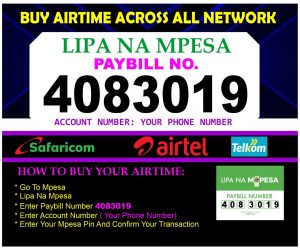Trademark Registration in Kenya
Trademarks are things we have all probably come across without knowing that they are trademarks. An example is the KEBS certification mark that is on all consumer products. They are identified as signs that distinguish a company’s product. The sign typically has distinctive letters, numbers, drawings, pictures, or colors to differentiate it from similar or identical products. So you want to start a company in Kenya and need a trademark? As Kenya Industrial Property Institute (2017) highlighted, here are the procedures to undertake.
While people may believe that registering a business and the trade name means that the business name would be protected as a trademark, it is a misconception as a trade name, and a Trademark are different. Every individual, company, or lawful association can apply for a trademark if they meet the Trade Marks Act requirements. These requirements include:
as a trade name, and a Trademark are different. Every individual, company, or lawful association can apply for a trademark if they meet the Trade Marks Act requirements. These requirements include:
- The name of the individual, firm, cooperative society, and company that want to register
- The applicant’s nationality as it determines the application cost
- The applicant’s postal address, email, and telephone number
- The Trademark’s representation
A trademark has to be registrable by containing at least one of the following:
- The name of the company, individual, or firm that is represented in a unique manner
- The applicant’s signature or their predecessor in the business
- An invented word/s
- Word/s that do not refer to the product’s quality, or geographical area
- Any distinctive mark
Trademarks Generally Excluded from Registration
- Marks that will probably cause confusion or deceit
- Marks closely resembling registered trademarks and are proposed to be registered in goods and services similar to those the registered trademarks cover.
- Touch, scent, and sound marks.
- Representations of the head of state of any foreign state or a colorable imitation
- The phrases Red Cross, Geneva cross, or other crosses in red.
- Any title or abbreviation of any international intergovernmental organization
- Marks consisting of or containing the Olympic symbol
Examples of Trademarks
The picture above highlights some of the well-known trademarks such as Coca-Cola, KEBS, Google, and Facebook.
Forms that applicants will interact with during registration include Forms TM 1, 2, 27, and 32.
- Form TM 1 is for foreign applicants who must appoint local agents for their registration.
- Form TM 2 is the application form for Trademark registration by all applicants.
- TM 27 is for the application for preliminary advice on distinctiveness; the form is not mandatory but valuable and highly advisable.
- Form TM 32 is for the application to enter the service’s address.
- There are other forms depending on an applicant’s individual changes or needs, but these are the basics.
Step 1: Preliminary Search
The first procedure in registering a trademark is a trademark name search. The search is to ensure that the trademark is registered and if there are records that could be confused with the intended trademark. The form involved in this stage is Form TM 27, which is also the application form for a name search.
Step 2: Registration Application
After the registrar has approved the search of Trademarks that the trademark is registrable, i.e. there is no existing trademark that can be confused with the trademark to be registered, applications for registration are made to the registrar. The form TM 2 and 32 are presented with seven representations of the trademark. For a foreign applicant, they apply for registration through an agent and accompanies the forms with Form TM 1 or a duly-completed power of attorney that is signed and duty stamped.
Step 3: Examination Stage
The application documents are checked to ensure they are correct; i.e. the forms filed are those that should be submitted. The trademark is checked again in this stage to ensure it does not resemble any mark. A report is then generated and issued to confirm whether the trademark registration has been approved. If approved, the applicant pays the advertisement and registration fee.
Step 4: Advertisement Stage
The trademark is advertised in the Kenya Industrial Property Institute (KIPI) journal for 60 days. This advertisement allows any individual who thinks the trademark matches theirs to object the trademark registration. Form TM 6 is filed in case of objections, which is the form for a notice of opposition, and opposition proceedings begin. If there is no objection, the applicant proceeds with the registration.
Step 5: Registration
This is the final stage, where the trademark is registered, and the applicant is given a certificate of registration of the Trademark.
Trademark Registration Costs
Application fee for preliminary name search: Ksh 3,000 for locals, $150 for foreigners.
Application fee for an application to register a trademark: Ksh 4,000 for locals, $200 for foreigners. The corresponding form in this stage is Form TM 2.
Trademark registration fee: Ksh 2,000 for locals, $150 for foreigners.
Advertisement fee: Ksh 3,000 for locals, $60 for foreigners
Importance of Trademark Registration in Kenya
Trademark registration gives one exclusive right to use their brand name, product, logo, and other features. This is because registration notifies other persons that a particular person owns the mark, which makes it a unique brand as other people are prevented from using it.
Trademark registration gives one the right and support to take legal action against third parties that infringe on the protected product. An infringement is when an individual or company uses a registered mark without the owner’s authorization. Thus, trademark registration allows one to institute proceedings for infringement. In case of infringement, when a mark is not registered, it gets difficult to prove in court.
Trademark registration gives a company or business a competitive advantage because it distinguishes the brand from other brands, which showcase quality. It also protects the brand from counterfeits which protects the business’s reputation.
Trademark registration also allows one to assign or transfer the trademark to others. This is because a registered trademark is transmissible and assignable. Transmission is defined as the transfer by operation of law, while an assignment is the allocation of the mark to another person. Assignment or transmission may be done at a value to the owner of the mark, and only the legal owner of the mark can transfer or assign it to another person.
In conclusion, it is essential to register a trademark for your business or company to protect your brand. The procedures for trademark registration are the trademark’s preliminary search, filing for the application to be registered, the examination of filed documents, the trademark’s advertisement, and the final registration, which involves the issuance of a certificate of registration of the Trademark.
Reach out to us via info@meclonconsultancy.co.ke for any help with Trademark registration
References
Kenya Industrial Property Institute. (2017). Trademark Registration Procedure. KIPI.



